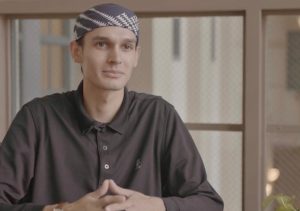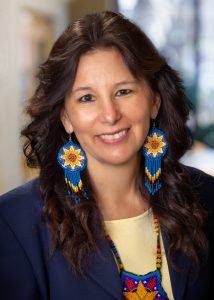“Seeing these Native 1Ls is a sign that we are still here and are thriving in spite of what was done to us.”

First-year student Weston Jones
Weston Jones chose to attend Mitchell Hamline because it occupies his people’s traditional lands. A member of the Oglala Lakota Nation who grew up on the Pine Ridge Indian Reservation in South Dakota, he says “there’s something about the land that helps me and helps me with my studies.”
“The law, especially federal law, is inseparable from Native identity and what it is to be Native,” said Jones, who added he had one goal in attending law school: To be able to work to get land back for his people.
“As a Native person you have a duty to take control of the future, and I believe that law and law school can help me build a better future for these generations coming up.”
Jones is one of eleven Native American first-year students at Mitchell Hamline this year, a record for the school.
The increase is part of a concerted effort by the school to attract more tribal-enrolled and tribal-descendant students to the school, according to Angelique EagleWoman (Wambdi A. Was’teWinyan), director of Mitchell Hamline’s Native American Law and Sovereignty Institute.

Professor Angelique EagleWoman
“I’m proud of the work we’ve done to bolster our offerings in Native American law,” she said. “We have a prominent program here.
“Our Native students study more than Native American law. That’s why it’s important for Mitchell Hamline to make itself a place where Indigenous students feel welcome.”
To that end, EagleWoman has been very active in meeting and working with Native students who attend a pre-law institute through the American Indian Law Center the summer before they start law school. Jones was among those students who attended; getting to know EagleWoman is another reason he says he felt welcome and wanted to attend Mitchell Hamline.
There’s also a new physical space at the school for Native students to be together – located in a room next to EagleWoman’s office. It’s a place where Native students can attend classes online in each other’s company; one corner also is set aside for ceremony.
“Seeing all these Native 1Ls is a sign that we are still here and are thriving in spite of what was done to us,” said GeWaden Dunkley (Bois Forte Band of Chippewa), a 3L who is president of Mitchell Hamline’s Native American Law Student Association (NALSA). “As with other marginalized groups, the majority of history since contact with Europeans omits Natives’ voices either by neglecting or actively suppressing them.
“This is compounded by the unique nation-to-nation relationship between Native communities and the United States that allowed the latter to create despicable laws that controlled every aspect of Native life.“

NALSA president GeWaden Dunkley
For Dunkley, he sees Native students seeking a law degree as a path towards striving “to be the voice of the voiceless and make change for those who were powerless.
“We are the dreams of the babies who died in the boarding schools and the last wish of those starved by broken promises.”
EagleWoman is now sole director of Mitchell Hamline’s Native American Law and Sovereignty (NALS) Institute after previously serving as co-director with Colette Routel. Routel recently became a judge in Hennepin County, Minn.
EagleWoman describes the moment as having come full circle, as a Dakota woman now leading a prominent Native American Law program on traditional Dakota land.
She first became a law professor at Hamline University School of Law in 2006, then spent a visiting year teaching Indigenous law at the University of Kansas, before moving west to establish a Native American law emphasis program at the University of Idaho College of Law, and serving as the first Indigenous law dean in Canada, at the Bora Laskin Faculty of Law in Thunder Bay.
She returned to Mitchell Hamline as a visiting professor in 2018, then a professor of law and co-director of the Native American Law and Sovereignty Institute in 2020.
EagleWoman has also served as general counsel for her tribe, the Sisseton-Wahpeton Oyate of the Lake Traverse Reservation, and currently serves as a justice on its Supreme Court.
“There is a great need for law graduates who know Native American law and an even greater need for Indigenous people to learn the law themselves so they can serve their peoples,” she said. “I look forward to expanding the work of the NALS Institute and strengthening tribal sovereignty in legal education.”
